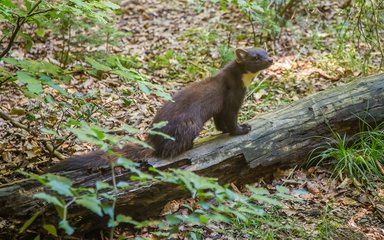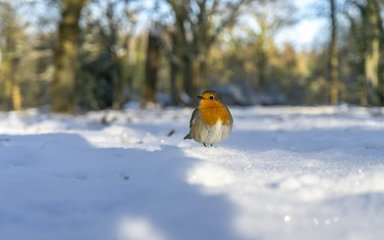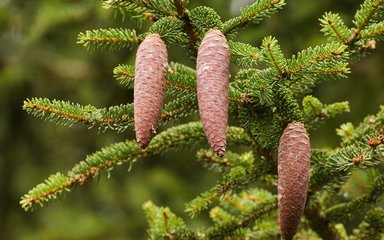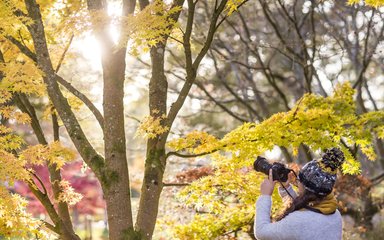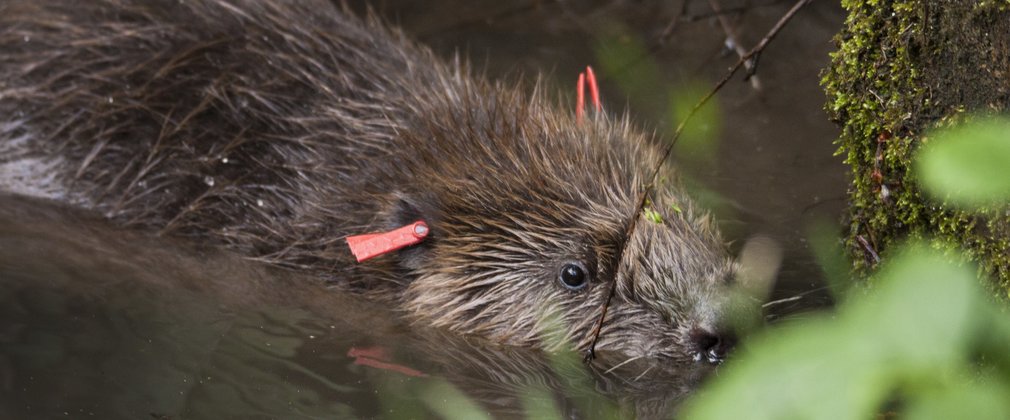
Once a key part of wetland habitats, these ecosystem engineers were hunted to extinction. Now they’re returning to our forests to see if they can help restore our wetlands and reduce the impact of flooding.
Walking along the water’s edge, small tree stumps dot the area. The wood has been chiselled into a pencil-like point, as if sharpened with a knife. Webbed hind footprints in the mud are another sign that a forester did not fell these trees. They were felled by one of nature’s greatest engineers, the beaver.
The Eurasian beaver is a large semi-aquatic mammal and one of the largest rodents in the world. Their thick, waterproof fur and broad, leathery tail make them excellent swimmers. Specially adapted claws on their hind feet help them keep their fur well-groomed. Well known for tree felling and dam building, beavers have huge orange teeth hardened with iron that they use to ‘coppice’ waterside trees by gnawing on the stems.
These charismatic creatures were once widespread throughout Britain. However, beavers were heavily hunted for their fur and scent glands that produce a substance called castoreum. By the beginning of the 16th century the beaver became extinct from the country. Their absence has changed landscapes ever since.
Ecosystem engineers
Beavers play an important role in complex wetland ecosystems, creating habitats for many other plant, insect and mammal species. Few other animals have the ability to modify and shape their surrounding environment like the beaver does. Their damming creates complex pools, providing both deeper water and shallow, fast-flowing areas, important for a range of aquatic life. Pools of standing water are also great for supporting frogspawn and tadpoles.
Coppicing by beavers opens up the canopy, increasing lights levels, creating areas of vegetation great for breeding birds that can feed on insects around the dams. How they feed increases deadwood, benefitting an abundance of invertebrates. For these reasons, beavers are often referred to as ‘ecosystem engineers’ and known as a keystone species. Where beavers return, they can help to restore an entire ecosystem.
Beavers can benefit people too. Beaver dams increase water storage and slow the flow of water downstream, potentially reducing the impact of flooding in the surrounding area. The dams are a real feat of engineering in themselves. The largest can be 2-metre-high woven structures of branches and vegetation packed with mud to hold back the water across rivers.
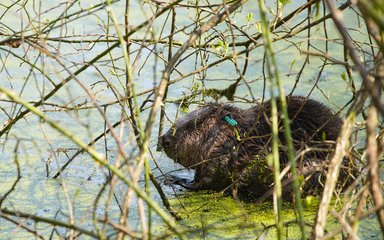
Return to English woodlands
In 2018 a pair of Eurasian beavers were introduced in an enclosed trial at Greathough Brook in the Forest of Dean. To make this happen, we worked with beaver experts Dr Roisin Campbell-Palmer and Derek Gow, University of Exeter and Ecosulis, with funding by Gloucestershire Environmental Trust and Forest Holidays. The beavers were released into a specially designed enclosure within 6 hectares of woodland so that their impact can be carefully monitored.
Our team have been using trail cameras located around the site to monitor the beaver’s activity and see what they’ve been up to. The beavers leave their burrows in the evening and start to work on maintaining the dams. Cutting willow and bramble with their chisel-like teeth, they carefully thread it into the dams to create deeper pools of water to conceal the underwater entrances to their burrows.
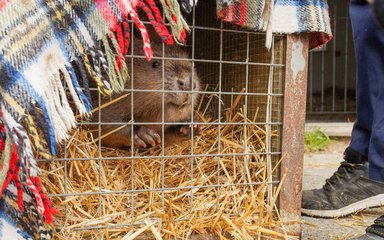
Then in April 2019, two adult beavers were also released into an enclosure in Cropton Forest in Yorkshire as part of a five-year trial, with funding from North York Moors National Park, Forest Holidays and North Yorkshire County Council. The main aim of this project is to see how they interact with the man-made woody dams in this area, working with researchers from universities of Leeds, Hull, Teesside and Exeter. Ecologist Cath Bashforth explains the benefits witnessed so far:
The changes to the environment have been amazing. There were two old ornamental fishponds on the site and these had become very shaded and silted-up, with the top pond holding very little water. The beavers set to work straight away. They have been plugging the leaks in the ponds and water levels in both have risen by over a metre. The beavers have also coppiced many of the trees overhanging the pond, opening it up to a lot more light.
The beavers’ work has resulted in a record amount of amphibians recorded at the site in recent years. Previously, just six clumps of spawn had been recorded in the area. Now the total amount of spawn is uncountable. Cath continues:
Because of the increased number of frogs and toads, over herons have now been regularly seen fishing around the pond, and otters and tawny owls have been caught on camera feasting on the amphibians. Teal and Mandarin ducks have been spotted on the site for the first time too, because of the increased water levels.
In addition to their work on the ponds, the beavers have built a large dam now 70 metres wide. Like the Forest of Dean beavers, this has significantly raised water levels upstream enabling them to burrow into the banks and create an underwater entrance into the lodge they have constructed on the riverbank. Cath concludes:
They have now extended this dam across the floodplain to hold back more water. The river here is now at least four times wider than it was before. As yet, the beavers have been swimming past the man-made woody structures and been concentrating on their own dams.
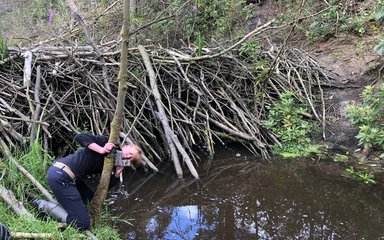
Growing beaver families
The Yorkshire beavers have also been busy growing their family with the patter of tiny webbed feet. Beavers give birth from spring to early summer and kits stay within the lodge for the first 1 or 2 months of their lives. The Cropton Forest pair had two kits the first year, who have both grown well and been helping the adults with habitat amendments and learning the ropes of tree felling.
Since the beavers have been in Cropton Forest their family has grown to 10 so far, with new kits born each year indicating a happy breeding pair. The new additions learned from the older siblings, who all take turns in raising the kits until they are ready to move on. In 2022 the oldest daughter found a new home at Sculthorpe Moor Nature Reserve in Norfolk. The three-year-old was paired with a Scottish male in the hope that they will breed and establish a new colony.
After a new female was introduced, the Greathough beaver project welcomed their first two kits in April 2023. We're excited to see the impact that the larger family will have on their environment.
Two more beaver projects added
In April 2024 a family of six beavers were released into a new enclosure in Wyre Forest, and in May a pair of beavers were introduced at a further site in the Forest of Dean, at Perry Hay.
All of our beaver projects have huge support from partners and our volunteers, who have been busy with wildlife surveys, monitoring the beavers and regularly checking the fences of the enclosures. We’ll continue to monitor the projects and measure the impacts of the enclosed beaver trials on the wider environment and local communities.
We hope to build on our success with further projects in the future, and fully supportive of seeing wild beavers back in the English landscape. One day, beavers may well be found across England once again.
Want more wildlife stories?
Follow the latest nature news from the forest

